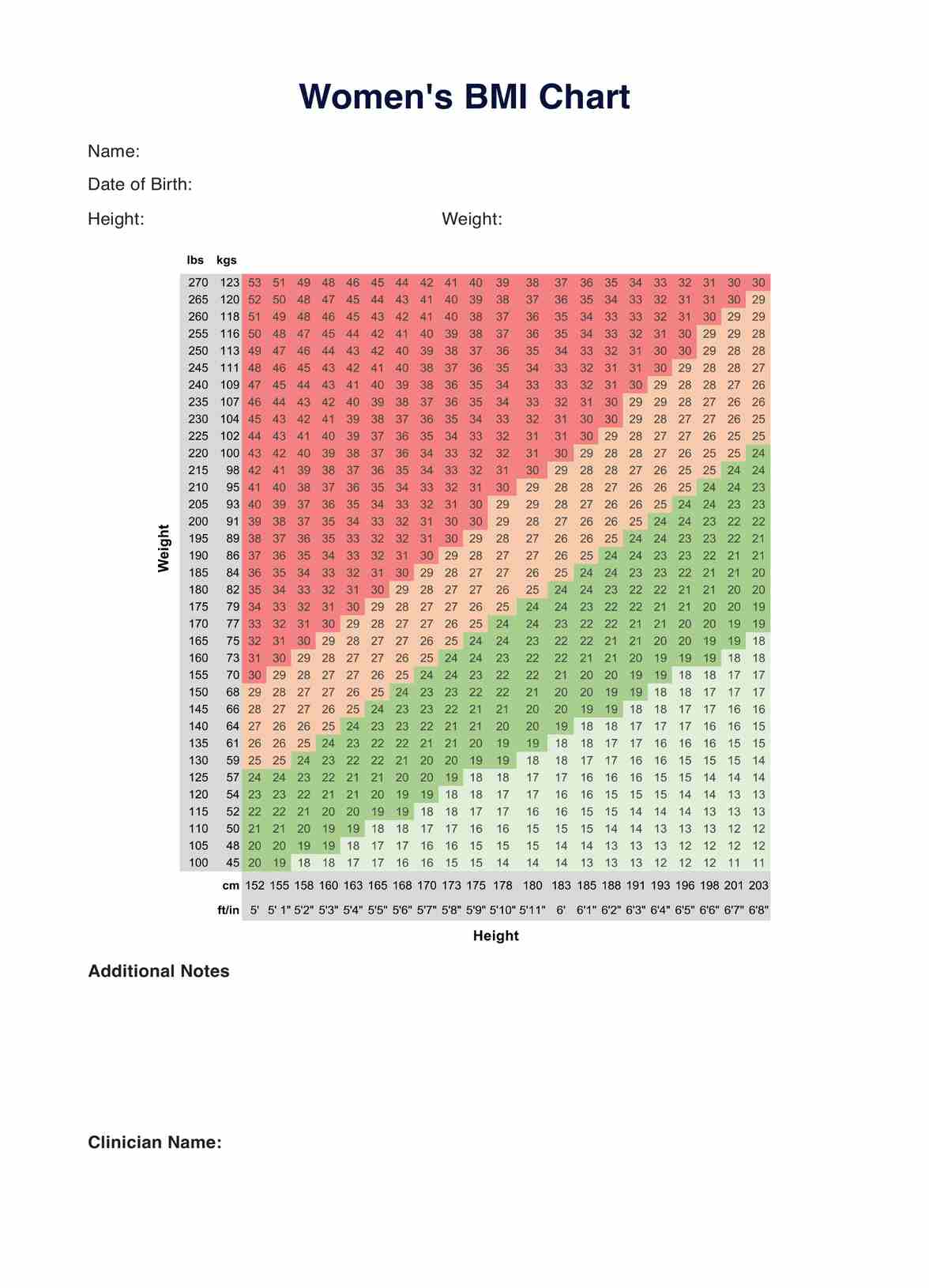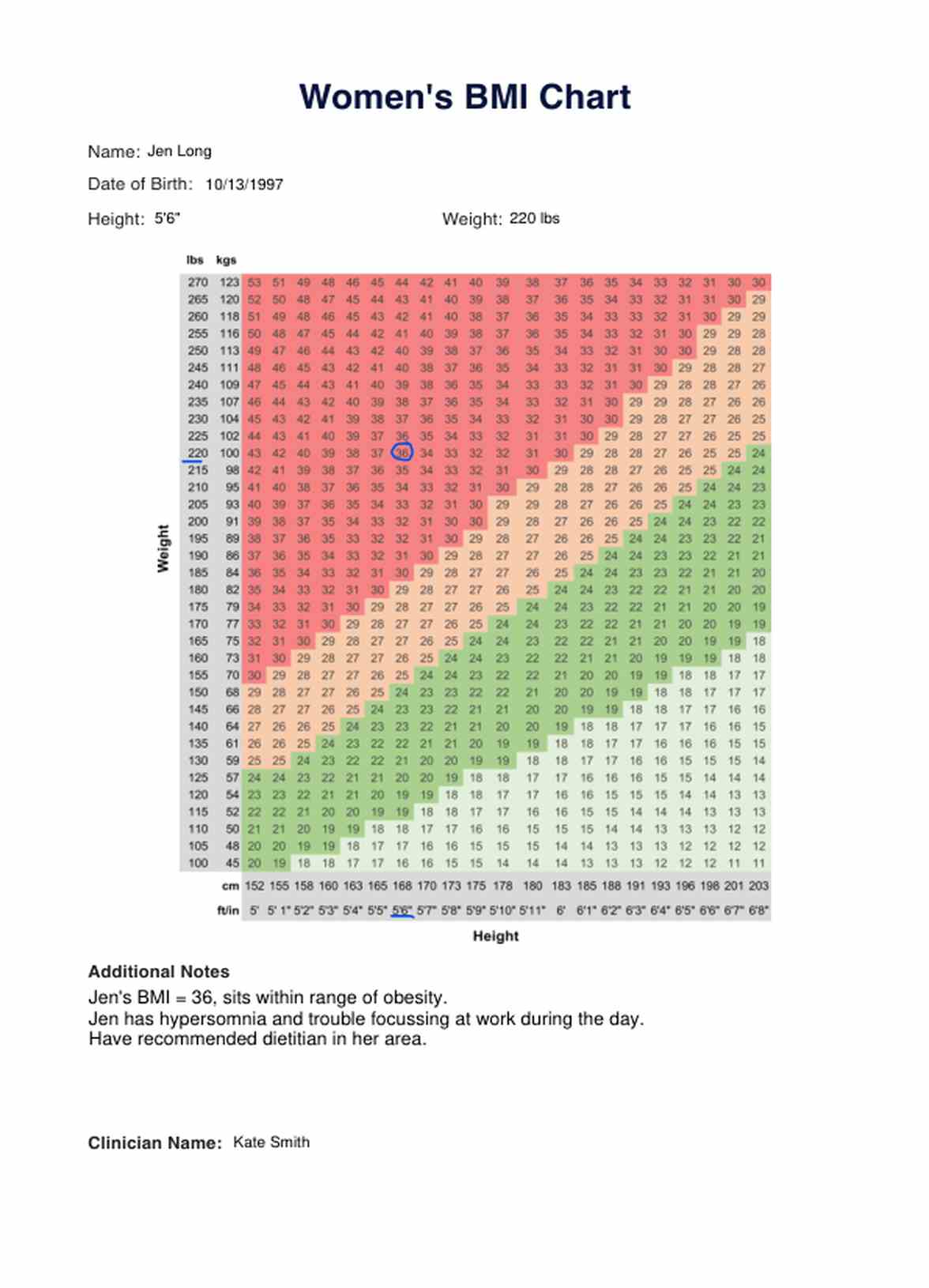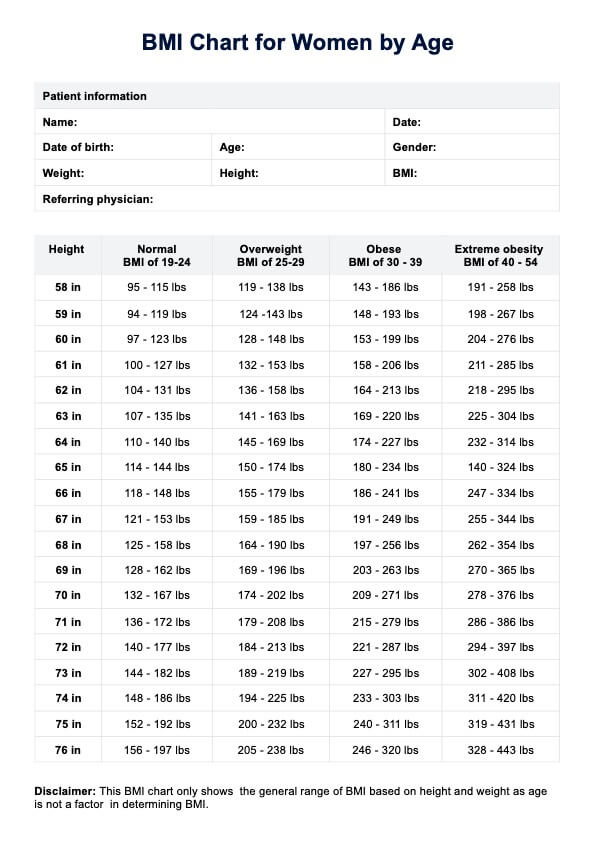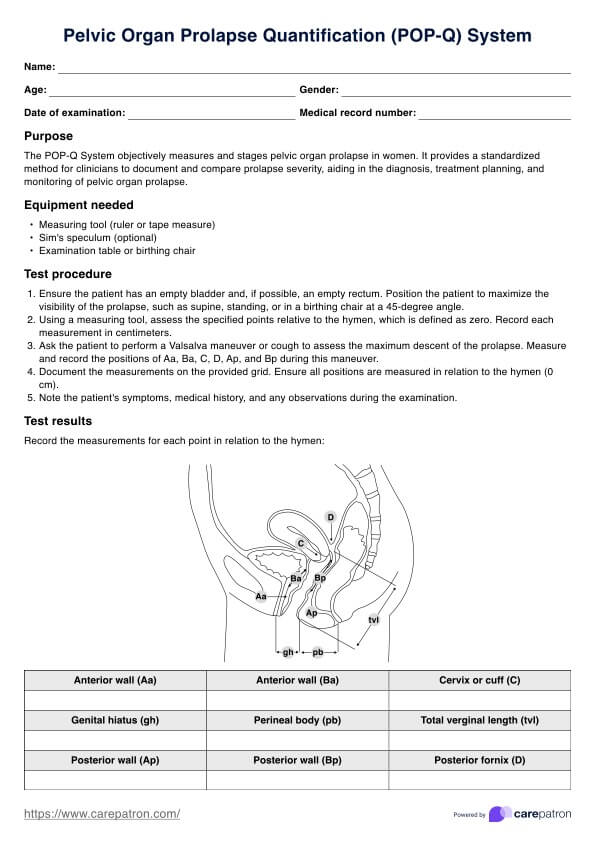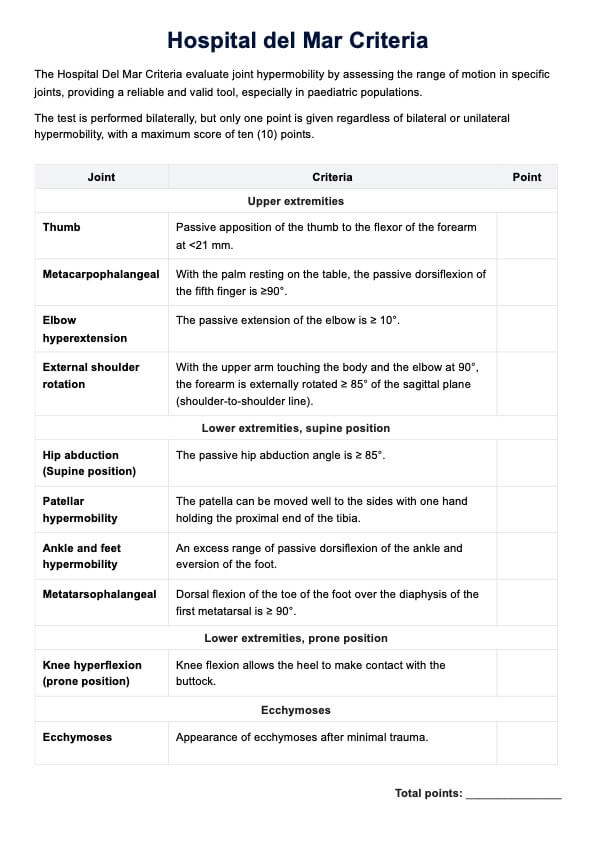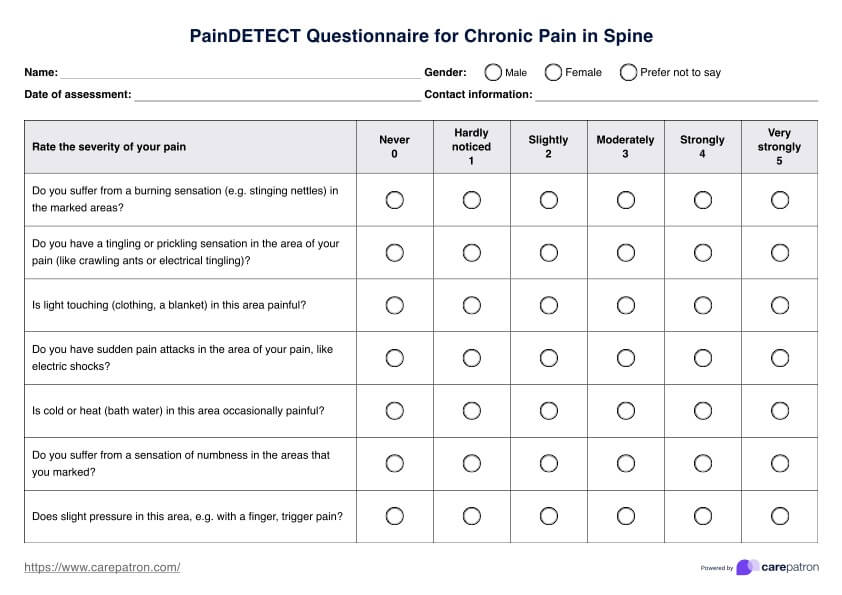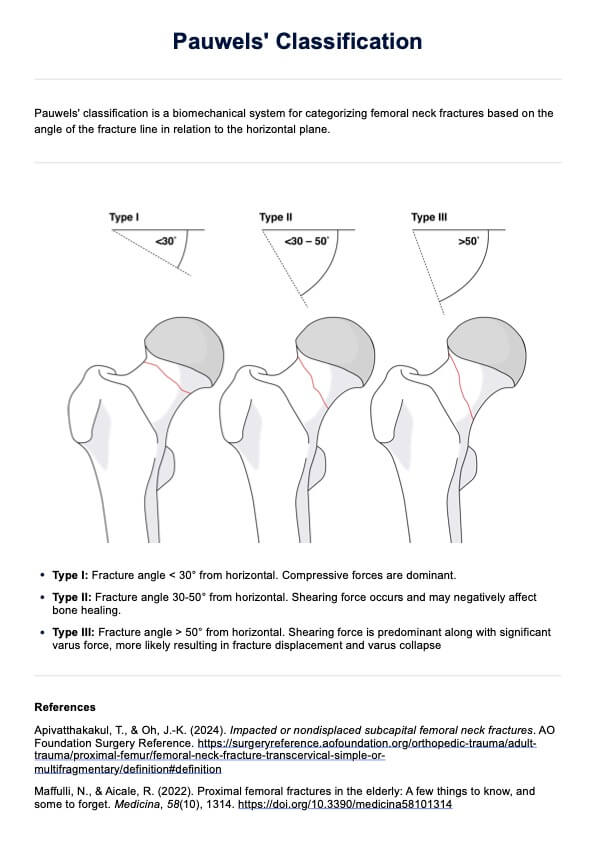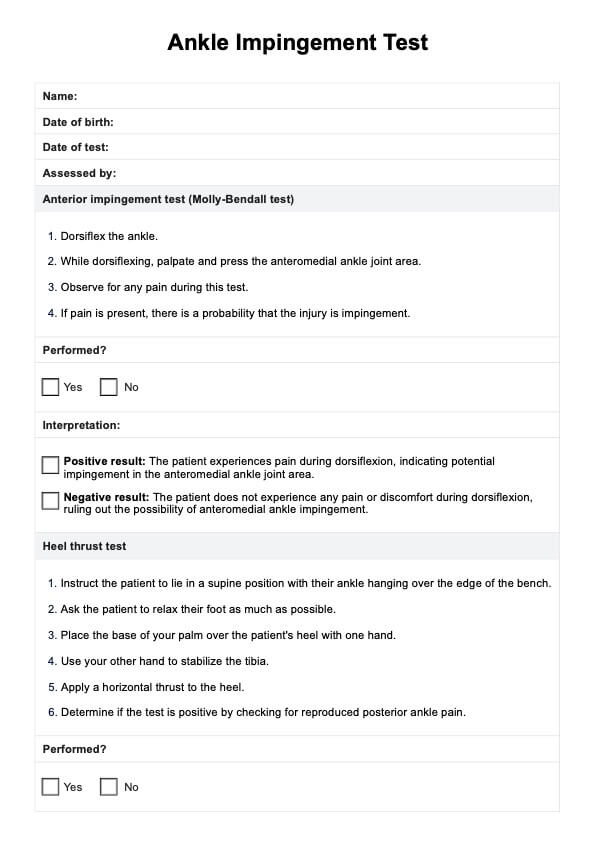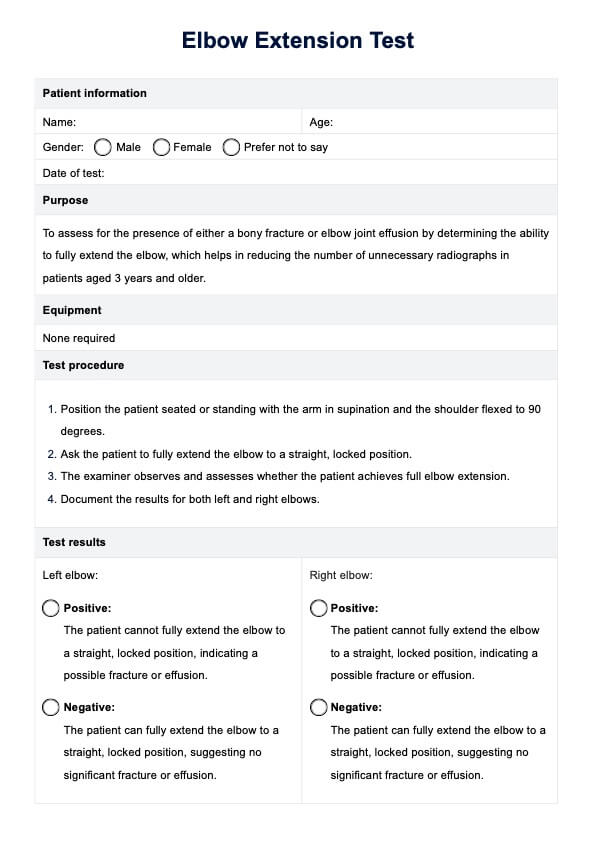Women's BMI Chart
Our Women's BMI Chart allows for easy determination of your patient's BMI along with color-coded BMI ranges.


BMI for women
It is important to understand the different factors affecting a person's weight and overall health in healthcare. While there are various methods for determining healthy weight ranges, one commonly used screening tool is the Body Mass Index (BMI) chart.
Body fat plays a crucial role in overall health, providing insulation and energy storage for the body. However, having too much body fat can lead to health problems such as obesity, diabetes, heart disease, and high blood pressure. Women tend to have a higher percentage of body fat than men, and their body fat distribution can also vary.
Body fat levels in women can be measured in various ways, including BMI, body fat percentage, and waist circumference. While BMI is a simple and widely used method, it does not consider factors such as muscle mass or body composition.
The World Health Organization (WHO) recommends using BMI and waist circumference as indicators of health risks. A high BMI combined with obesity or a large waist circumference can increase the likelihood of health problems related to excess body fat, such as metabolic syndrome and cardiovascular disease.
BMI is a measure of body fat based on height and weight, which can help indicate if a person is at an increased risk for health problems. BMI is defined numerically as:
BMI = weight (kg) ÷ height² (m²)
To determine your patient's BMI, you can use a BMI calculator, or with just your patient's height and weight, you can determine their BMI using our Women's BMI Chart. To see how to do this, keep reading!
Women's BMI Chart Template
Women's BMI Chart Example
How to use this Women's BMI Chart
Just follow the simple steps below to save time on BMI calculations using our Women's BMI Chart.
1. Measure height and weight
The two measurements you will need to use in this Women's BMI Chart are your patient's height and weight. While for calculation of BMI, the height must be in centimeters and the weight must be in kilograms, our chart also includes feet/inches and pounds for ease of use.
2. Find the corresponding BMI on the Women's BMI Chart
Locate your patient's height on the x-axis and their weight on the y-axis. Drawing a line outwards from each point, the corresponding BMI is the square that aligns with these two values. See our example below for a visual depiction.
3. Use color coding to interpret the BMI result
The colors provided show the interpretation of your patient's BMI result. The color coding can be interpreted as:
- Red - Obese BMI range (≥30)
- Orange- Overweight BMI range (25-29.9)
- Green- Normal BMI range (18.5-25)
- Pale green- Underweight BMI range (<18.5)
4. Add additional notes in the space provided
As we go into further detail below, many factors can impact BMI beyond excess body fat, so add context, notes, or recommendations in the space provided.
BMI measurement: now what?
After calculating an individual's BMI value, it's essential to take the following steps toward promoting their overall health. While BMI is a helpful tool for assessing weight status, it doesn't provide information about other factors, such as body composition or fat distribution.
A person with a "normal" BMI may have a high body fat percentage and an increased risk for health problems. On the other hand, someone with a "high" BMI may have greater muscle mass and a lower percentage of body fat rather than needing to lose weight.
A healthy BMI is, therefore, not universal across all women, and that's where additional factors like body fat levels and body composition come into play. These measurements can provide a more accurate understanding of an individual's weight status, health, and risk factors.
Maintaining a healthy weight range is essential for overall health and well-being. It reduces the risk of health problems and promotes better bone mass, muscle mass and strength, and energy levels. Individuals can make better-informed health decisions about their diet and exercise routine to maintain a healthy weight range by focusing on body fat percentage and overall body composition.
Healthy weight range and body fat distribution
The healthy weight range for an individual is determined by their BMI value, which considers their height and weight. However, it's also crucial to consider the distribution of body fat. Carrying excess fat around the waist, also known as belly fat, can pose a greater risk of health problems than a more evenly distributed body fat.
You can use a few methods to assess body fat distribution. One approach is measuring waist circumference, which involves measuring the distance around the narrowest part of the waist. Another method is calculating the hip-to-waist ratio, which compares the hips and waist measurements. Both of these measurements can provide valuable insights into body fat distribution.
For women, a waist measurement greater than 35 inches and for men, a waist measurement greater than 40 inches may indicate a higher risk of various health conditions and complications associated with excess belly fat. By understanding and monitoring body fat distribution, individuals can take proactive steps towards maintaining a healthy weight and reducing the potential for health issues in the long run.
Weight gain recommendations during pregnancy based on BMI
For pregnant women or those planning to become pregnant, it's essential to understand the healthy weight range and how it may differ from non-pregnant individuals. The American College of Obstetricians and Gynecologists recommends the following weight gain guidelines based on pre-pregnancy BMI:
- Underweight (BMI less than 18.5): 28-40 pounds
- Normal weight (BMI 18.5-24.9): 25-35 pounds
- Overweight (BMI 25.0-29.9): 15-25 pounds
- Obese (BMI greater than or equal to 30.0): 11-20 pounds
Pregnant women need to gain weight within these ranges to support their baby's growth and development while maintaining a healthy weight for themselves.
Limitations of using BMI to measure women's health
While BMI is a commonly used measurement to determine weight status, it has some limitations regarding measuring women's health. BMI does not consider fat distribution, bone density, or muscle mass.
By analyzing the BMI value with other health indicators, such as waist circumference and overall body composition, you can gain further insights into your patients' well-being and develop personalized strategies for promoting optimal health.
Women tend to have a higher body fat percentage than men, and their bodies also store more fat in areas such as the hips and thighs. This can result in a higher BMI even if the person is physically fit and has a healthy body composition.
On the other hand, athletes and individuals with high muscle mass may have a higher BMI due to their increased weight from muscle, but this does not necessarily mean they have an unhealthy fat level.
Five ways to measure health and weight (with or without BMI)
- Body Composition Analysis: This method uses specialized equipment to measure the fat, muscle, and bone mass percentage in one's body. It considers factors such as age, gender, and physical activity level to assess overall health accurately.
- Waist-to-Hip Ratio: Measuring the circumference of your waist and hips can indicate your body fat distribution. A higher waist-to-hip ratio may indicate excess belly fat, which is linked to a higher risk of health problems such as cardiovascular disease and type 2 diabetes.
- Skinfold Calipers: This method involves using calipers to measure the thickness of skinfolds at different body areas, which can then be used to estimate body fat percentage. While not as accurate as body composition analysis, it can still provide a reasonable estimate of overall body fat levels.
- Bioelectrical Impedance Analysis (BIA): BIA measures the flow of electrical currents through the body to estimate body fat percentage. This method is relatively quick and non-invasive, making it a popular choice for healthcare professionals.
- Health Risk Assessment: A person's overall health and lifestyle habits can also indicate weight and potential health risks. Factors such as smoking, sedentary behavior, and diet can all contribute to an increased risk of health problems, regardless of one's body composition or BMI.
Commonly asked questions
The BMI categories of underweight, healthy weight, overweight, and obese are the same for men and women- despite the generally higher body fat percentage in women, and differences in body fat distribution. This is just one of the limitations of BMI in providing a comprehensive view of health.
To calculate BMI numerically, you have to use these units. However, our BMI Chart provides centimeters, feet, kilograms, and pounds to enable easy use for whichever units you prefer. This chart also saves you from having to do any calculations, so you can use this chart anywhere you need- without a calculator.
BMI is only determined by height and weight and does not consider body composition, muscle mass, or individual differences. As such, BMI should be used with care and not as a definite measure of overall health.


